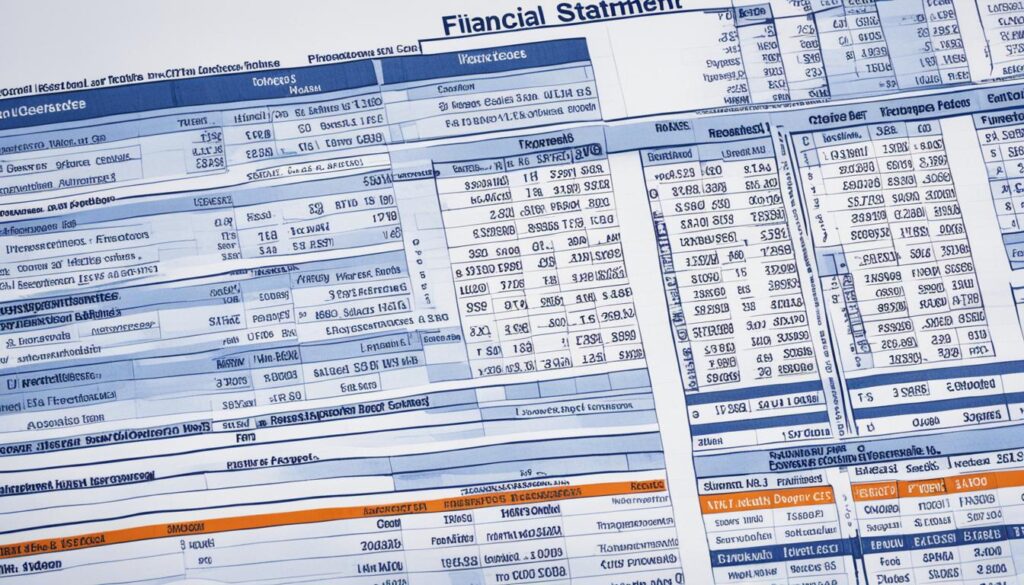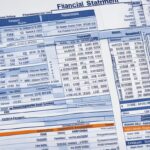A business financial statement is a written record that conveys the financial activities of a company. It is essential for understanding a company’s financial condition and profitability. The primary financial statements for a for-profit business include the balance sheet, income statement, statement of cash flow, and statement of changes in equity. These statements provide an overview of a company’s assets, liabilities, shareholders’ equity, revenues, expenses, and cash flows. The balance sheet shows the company’s financial position at a specific point in time, while the income statement focuses on the company’s revenues and expenses during a particular period. The cash flow statement tracks how a company uses its cash to pay its debts and fund its operating expenses and investments. These financial statements are crucial for financial analysis and decision-making.
Key Takeaways:
- A business financial statement is a written record that conveys the financial activities of a company.
- The primary financial statements for a for-profit business include the balance sheet, income statement, statement of cash flow, and statement of changes in equity.
- These statements provide an overview of a company’s assets, liabilities, shareholders’ equity, revenues, expenses, and cash flows.
- The balance sheet shows the company’s financial position at a specific point in time, while the income statement focuses on the company’s revenues and expenses during a particular period.
- The cash flow statement tracks how a company uses its cash to pay its debts and fund its operating expenses and investments.
Understanding Financial Statements
Financial statements play a crucial role in evaluating a company’s financial health and analyzing its earnings potential. Investors, financial analysts, and creditors rely on these statements to gain insights into a company’s overall financial performance. By understanding financial statements, stakeholders can make informed decisions and predict future stock prices.
The annual report serves as a valuable resource for obtaining reliable and audited financial data. Financial statements in the United States are typically prepared based on Generally Accepted Accounting Principles (GAAP), ensuring consistency and comparability across different companies.
It is important to note that nonprofit organizations have a different set of financial statements tailored to their unique reporting requirements. By comprehending financial statements, analysts can effectively assess a company’s performance, identify trends, and conduct in-depth financial analysis.
Financial statements provide a wealth of information, including balance sheets, income statements, and cash flow statements. These statements offer valuable insights into a company’s assets, liabilities, revenues, expenses, and cash flows – all of which are essential for evaluating its financial stability and making informed investment decisions.
Ultimately, understanding financial statements is a fundamental skill for conducting thorough financial analysis and ensuring the financial well-being of a company. By analyzing the data presented in these statements, businesses can identify strengths and weaknesses, make strategic decisions, and drive success in today’s competitive market.
Components of a Balance Sheet
The balance sheet is a fundamental financial statement that provides a snapshot of a company’s financial position at a specific moment in time. It consists of three main components: assets, liabilities, and shareholders’ equity.
Assets are the resources owned by the company that have economic value. These can include cash, accounts receivable, inventory, property, and investments. Assets are essential for a company’s operations and can be categorized as current assets (expected to be converted to cash within a year) or non-current assets (expected to be held for more than a year).
Liabilities represent the company’s obligations, such as accounts payable, loans, and long-term debt. Liabilities are amounts owed to creditors and must be settled in the future. Like assets, liabilities can be classified as current liabilities (due within a year) or long-term liabilities (due after a year).
Shareholders’ equity is the residual interest in the company’s assets after deducting liabilities. It represents the owners’ investment in the business and includes retained earnings and stockholders’ equity. Shareholders’ equity reflects the accumulated profits or losses of the company over time.
The balance sheet serves as a crucial tool for assessing a company’s financial health and stability. It helps determine the company’s liquidity, solvency, and overall financial position, enabling investors and creditors to make informed decisions.
Components of an Income Statement
The income statement is a key financial document that provides insights into a company’s profitability and overall financial performance. It showcases the revenues, expenses, and net income or loss over a specific period, allowing stakeholders to assess the company’s ability to generate profits and control expenses.
At the heart of the income statement are the revenues, which represent the income generated from selling products or services. Revenues are essential for evaluating a company’s financial success and growth potential. They provide a clear indication of the company’s ability to attract customers and generate sales.
Expenses are another crucial component of the income statement. They encompass the costs associated with various aspects of a company’s operations, including manufacturing, marketing, salaries, and other business activities. It is important to carefully evaluate these expenses to ensure efficient resource allocation and cost management.
By subtracting the expenses from the revenues, the income statement calculates the net income or loss. Net income represents the company’s profit over the specified period, while a net loss indicates a negative financial outcome.
Investors, creditors, and analysts heavily rely on the income statement to evaluate a company’s financial viability and sustainability. It helps them understand the company’s revenue sources, expense trends, and overall financial health, enabling them to make informed investment or lending decisions.
| **Revenue** | |
|---|---|
| Product Sales | $500,000 |
| Service Revenue | $250,000 |
| **Expenses** | |
| Cost of Goods Sold | $200,000 |
| Marketing Expenses | $50,000 |
| Salaries and Benefits | $100,000 |
| **Net Income** | $400,000 |
As seen in the example above, the income statement clearly outlines the company’s revenues and various expense categories. It calculates the net income by subtracting the total expenses from the total revenues, providing a snapshot of the company’s financial performance during the specified period.
Analyzing the income statement helps businesses identify areas that need improvement and make strategic financial decisions to optimize profitability and control expenses.
Components of a Cash Flow Statement
The cash flow statement is an important financial statement that tracks the movement of cash within a company. It provides insights into the company’s cash flow position, financial flexibility, and ability to meet its financial obligations.
The cash flow statement consists of three main components:
1. Operating Activities
The operating activities section of the cash flow statement shows the cash generated from the company’s core business operations. This includes cash from customers, payments to suppliers, and employee wages. Operating cash flow is a key indicator of a company’s ability to generate cash from its day-to-day operations.
2. Investing Activities
Investing activities represent cash flows related to buying or selling assets. This can include cash spent on purchasing equipment or property, as well as proceeds from the sale of assets. Investing cash flow provides insights into a company’s investments in long-term assets and its ability to generate returns on those investments.
3. Financing Activities
Financing activities involve cash flows related to funding the company. This can include issuing or repurchasing stock, paying dividends to shareholders, or taking out loans. Financing cash flow shows how a company raises capital and manages its debt obligations.
The cash flow statement is an essential tool for analyzing a company’s financial health. It allows investors, creditors, and financial analysts to assess a company’s ability to generate cash, its financial stability, and its capacity to fund its operations and growth initiatives.
By analyzing the components of a cash flow statement, stakeholders can gain valuable insights into a company’s cash flow position and make informed decisions regarding investment, credit, and financial strategies.
Conclusion
Understanding and analyzing business financial statements play a crucial role in assessing the financial health, profitability, and investment potential of a company. The balance sheet provides a comprehensive overview of the company’s financial position, showcasing its assets, liabilities, and shareholders’ equity. By examining the income statement, one can gain insights into the company’s profitability and revenue generation. The cash flow statement, on the other hand, tracks the company’s cash flow activities, including operating, investing, and financing activities.
These financial statements serve as vital tools for various stakeholders, including investors, creditors, and regulators, in evaluating and making informed decisions about a company’s financial performance. By conducting financial health analysis and carefully reviewing these statements, businesses can gain valuable insights into their operations. It allows them to identify areas for improvement, make data-driven decisions, and plan effectively for future growth and success.
In conclusion, financial reporting through business financial statements is instrumental in understanding a company’s financial status and making sound business decisions. By diligently analyzing these statements and conducting financial health analysis, businesses can enhance their financial performance, mitigate risks, and position themselves for long-term sustainability and profitability.








